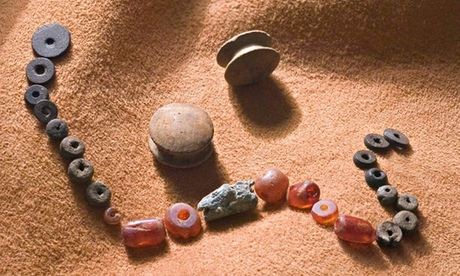Welcome to DU!
The truly grassroots left-of-center political community where regular people, not algorithms, drive the discussions and set the standards.
Join the community:
Create a free account
Support DU (and get rid of ads!):
Become a Star Member
Latest Breaking News
General Discussion
The DU Lounge
All Forums
Issue Forums
Culture Forums
Alliance Forums
Region Forums
Support Forums
Help & Search
4,000-year-old Dartmoor burial find rewrites British Bronze Age history [View all]

Some 4,000 years ago people carried a young woman's cremated bones – charred scraps of her shroud and the wood from her funeral pyre still clinging to them – carefully wrapped in a fur, along with her most valuable possessions packed into a basket, up to one of the highest and most exposed spots on Dartmoor, and buried them in a small stone box covered by a mound of peat.
The discovery of her remains is rewriting the history of the Bronze Age moor. The bundle contained a treasury of unique objects, including a tin bead and 34 tin studs which are the earliest evidence of metal-working in the south-west, textiles including a unique nettle fibre belt with a leather fringe, jewellery including amber from the Baltic and shale from Whitby, and wooden ear studs which are the earliest examples of wood turning ever found in Britain.
The site chosen for her grave was no accident. At 600 metres above sea level, White Horse hill is still so remote that getting there today is a 45-minute walk across heather and bog, after a half-hour drive up a military track from the nearest road. The closest known prehistoric habitation site is far down in the valley below, near the grave of the former poet laureate Ted Hughes.
Analysing and interpreting one of the most intriguing burials ever found in Britain is now occupying scientists across several continents. A BBC documentary, Mystery of the Moor, was first intended only for local broadcast, but as the scale of the find became clear, it will now be shown nationally on BBC2 on 9 March.
http://www.theguardian.com/science/2014/mar/09/dartmoor-burial-site-bronze-age-history
InfoView thread info, including edit history
TrashPut this thread in your Trash Can (My DU » Trash Can)
BookmarkAdd this thread to your Bookmarks (My DU » Bookmarks)
22 replies, 3092 views
ShareGet links to this post and/or share on social media
AlertAlert this post for a rule violation
PowersThere are no powers you can use on this post
EditCannot edit other people's posts
ReplyReply to this post
EditCannot edit other people's posts
Rec (33)
ReplyReply to this post
22 replies
 = new reply since forum marked as read
Highlight:
NoneDon't highlight anything
5 newestHighlight 5 most recent replies
= new reply since forum marked as read
Highlight:
NoneDon't highlight anything
5 newestHighlight 5 most recent replies
4,000-year-old Dartmoor burial find rewrites British Bronze Age history [View all]
dipsydoodle
Mar 2014
OP
if you subtract the Indo-European from Celtic you get a few scraps of their language
MisterP
Mar 2014
#21